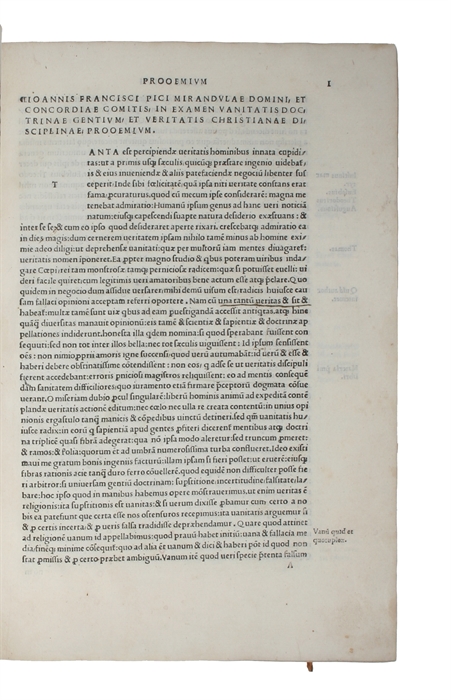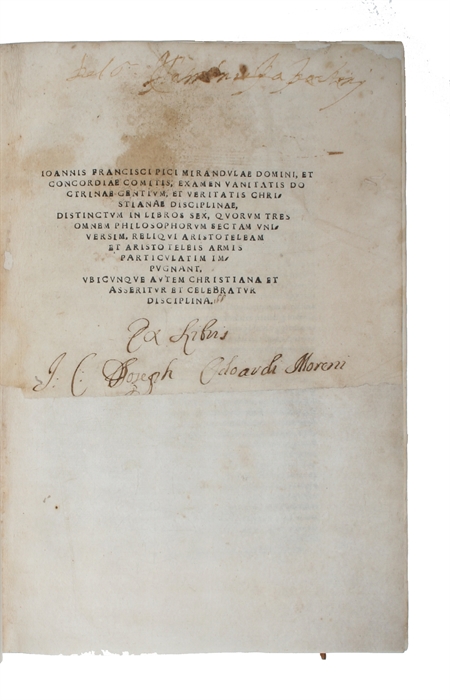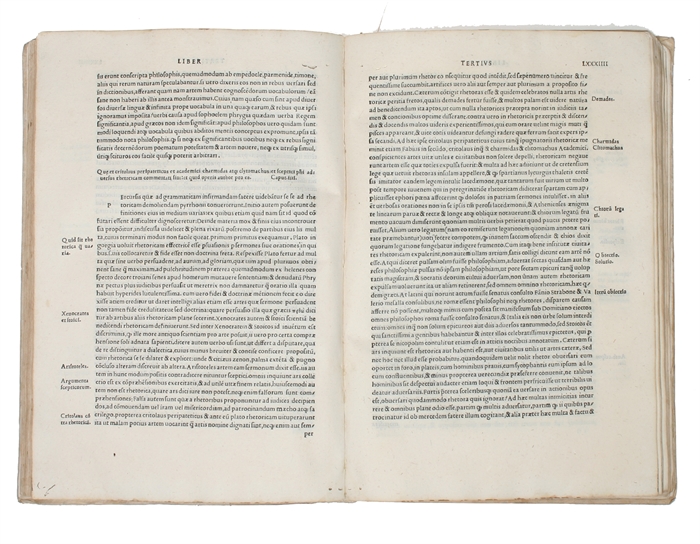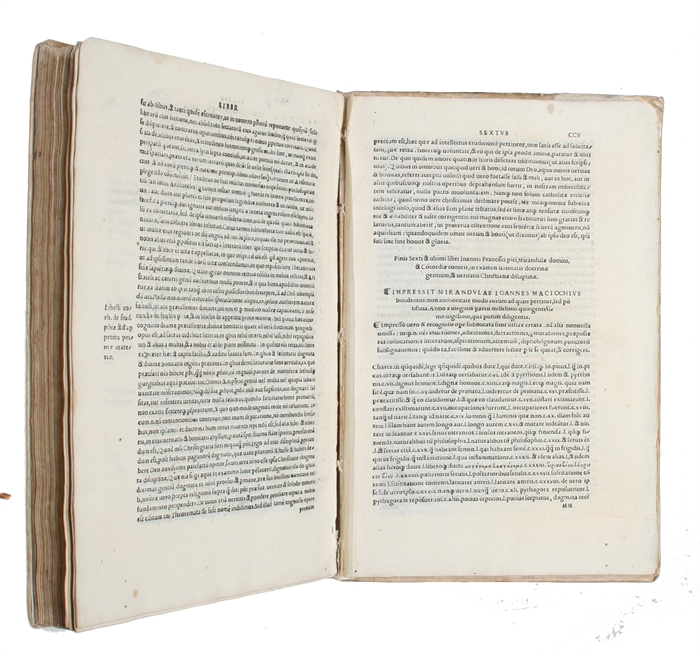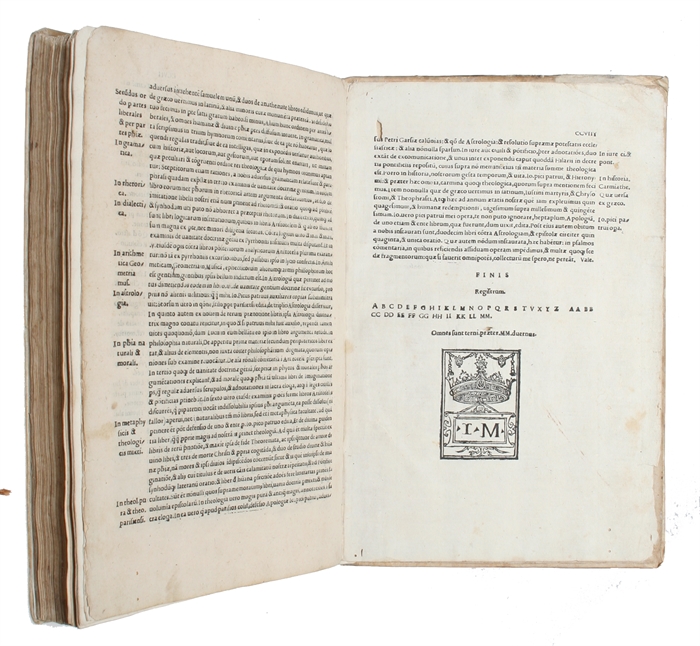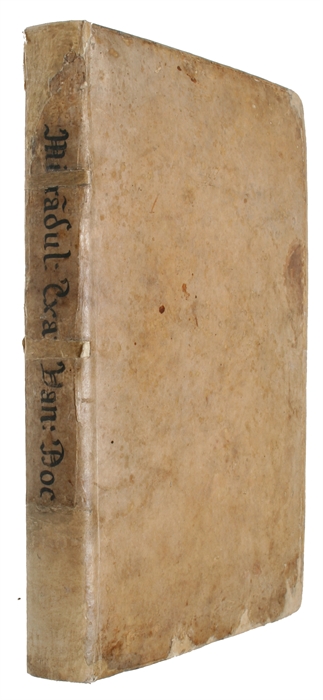THE FIRST PUBLIC INTRODUCTION OF GREEK SCEPTICISM TO THE MODERN WORLD
PICO DELLA MIRANDOLA, GIOVANNI FRANCESCO [GIANFRANCESCO, GIANFRAN, JOHANNES FRANCISCUS PICUS].
Examen vanitatis doctrinae gentium, et veritatis christianae disciplinae, distinctum in libros sex, quorum tres omnem philosophorum sectam universim, reliqui aristoteleam et aristotelis armis particulatim impugnant. Ubicunque autem Christiania et asseritur et celebratur disciplina.
Mirandulae, Ioannes Maciochius Bundenius, 1520 (on colophon). [Mirandola, Mazzocchi].
Small folio. Contemporary full vellum binding with handwritten title to spine. Author written in contemporary hand to lower edge. Binding professionally restored, at lower part of spine, edges of boards, and corners of back board. Free end-papers renewed. First leaf restored, with lower blank part supplied in later paper - no loss of text! This lower part was blank on both recto and verso. A bit of soiling to upper part of this leaf, as well as two old owner's inscriptions. First few leaves a bit browned, not heavily. Otherwise only light scattered browning. Some small marginal worm-holes to inner and lower blank margins, far from affecting text. All in all very fine, nice, and clean. Woodcut device to final leaf. (6), 208 ff.
The seminal first edition of Gianfrancesco Pico's main work, the work which publicly introduces Greek scepticism to the modern world (i.e. the Reniassance) for the first time and thus comes to play a seminal role in the development of modern thought. With this work, Pico becomes the first modern thinker to specifically use the theories of Sextus Empiricus, foreshadowing the great "Sceptical Revolution" of the later Renaissance as well as the ideas of later modern thinkers such as Montesquieu. The "Examen" furthermore introduces other important critiques of Aristotle that were not generally known at the time (and works that had not yet been published) as well as a completely new sort of attack upon the theories of Aristotle that come to play an important role in later Renaissance Aristotle scholarship.
"But his "Examen Vanitatis Doctrinae Gentium et Veritatis Disciplinae Christianae" is not only a criticism of human knowledge which can, as has been done, be compared with Montaigne. It is also a wholesale destruction of the whole world of human values, of that "regnum hominis" so dear to the Renaissance. And as such, it inclines one to think that it anticipated Pascal. [...]." (Garin, p. 135)
The "Examen" is considered foundational in "anti-pagan" historiography of thought, "a work that deserves special attention here as the earliest example of an "anti-pagan" reaction in the Renaissance historiography of thought, and as the first in a line of publications preparing the way for the anti-apologists of the seventeenth century. ..." (Hanegraaff, "Esotericism and the Academy: Rejected Knowledge in Western Culture", p. 81).
It is due to this work that Gianfr. Pico is now remembered as "the first modern sceptic".
"Joining the sceptical arguments of Sextus, which he quoted and used liberally, to Savonarola's negative view of natural knowledge, he presented the first text since antiquity utilizing Pyrrhonism, using it to illuminate knowledge by faith!" (Popkin, p. 24).
Gianfr. Pico, a learned scholar and apt reader of classical texts, was the first Renaissance thinker that we know to have seriously studied and used the works of Sextus Empiricus, which were not printed until the 1560'ies, causing a revolution in Renaissance thinking. "No discovery of the Renaissance remains livelier in modern philosophy than scepticism". (Copenhaver & Schmitt, p. 338). "The revived skepticism of Sextus Empiricus was the strongest single agent of disbelief". (ibid., p. 346).
"The printing of Sextus in the 1560s opened a new era in the history of scepticism, which had begun in the late fourth century BCE with the teachings of Pyrrho of Elis. [...] Before the Estienne and Hervet editions, Sextus seems to have had only two serious students, Gianfrancesco Pico at the turn of the century and Francesco Robortello about fifty years later." (Copenhaver & Schmitt, pp. 240-41).
"No significant use of Pyrrhonian ideas prior to the printing of Sextus' ""Hypotyposes" [in the 1560'ies] has turned up, except for that of Gianfrancesco Pico della Mirandola". (Popkin, p. 19).
Giovanni Francesco [Gianfranceso] Pico della Mirandola (1470-1533), not to be confused with his uncle Giovanni Pico della Mirandola (1463-1494) was a highly important Renaissance thinker and philosopher, who was strongly influenced by the Neoplatonic tradition, but even more so by the preaching of Girolamo Savonarola, whose thought he defended throughout his life.
Just like his uncle, Gianfr. Pico devoted his life to philosophy, but being a follower of Savonarola and having a Christian mission, he made it subject to the Bible. He even depreciated the authority of the philosophers, above all of Aristotle.
It is in the "Examen", Gianfr. Pico's main work, that his sceptical arguments are developed to their fullest extent, and it is here that he not only discusses at length Pyrrhonism, based on Sextus' "Hypotyposes"( which were only published more than 40 years later), and deals in detail with Sextus' "Adversus Mathematicos" (also only published more than 40 years later), propounding his own ideas and attacking Aristotle, he also provides lengthy "summaries" of Sextus' texts, which seem more like actual translations than interpretations or paraphrases.
As Charles Schmitt also shows, the younger Pico must have read Sextus in a Greek manuscript, as the texts of Sextus were not printed before the 1560'ies, when the Hervet- and the Estienne-editions appear, causing what we would call "´The Sceptical Revolution of the Renaissance", a turning point in the history of modern thought. Apparently, Gianfr. Pico used a codex that belonged to Giorgio Antonio Vespucci. It was during an enforced exile around 1510 that Gianfr. Pico set to work on his "Examen Vanitatis Doctrinae Gentium", which was published for the first time in 1520 and dedicated to Pope Leo X. The work was printed in a small edition by an obscure press in his own little principality at Mirandola, which explains its scarcity.
In the "Examen" "Pico introduced the actual sceptical arguments of Sextus Empiricus, plus some newer additions, in order to demolish all philosophical views, especially those of Aristotle, and to show that only Christian knowledge, as stated in the Scriptures, is true and certain." (Popkin, pp. 20-21). But although he here carefully set forth the ancient sceptical criticisms of sensory knowledge claims and of the rational criteria that let us judge what is true and false, it is important to remember that he did not as such advocate scepticism, rather, he used it for his own means. Using the ancient sceptical arguments as ammunition to undermine the confidence in natural knowledge, his aim was to lead people to see that the only real and reliable knowledge is revealed knowledge. He denounces all pagan philosophical claims, attacks Aristotle's theory of knowledge with the arguments of Sextus, all the time regarding Christianity as immune to sceptical infection, because it does not depend upon the dogmatic philosophies that Sextus had refuted.
In his use of Sceptical arguments, Gianfr. Pico was not only doing something completely new in a Renaissance setting (i.e. reviving and using sceptical arguments at all), he was doing something completely new as such. The original Pyrrhonian formulations were primarily directed against Stoic and Epicurean theories of knowledge, and traditionally they were not directed towards the all-overshadowing dominating theories of Aristotle. As such, Gianfr. Pico makes Aristotelianism more of an empirical theory than it was traditionally viewed, and also in this did the "Examen" come to have groundbreaking influence. He furthermore introduces several critiques of Aristotelianism that were not generally known at the time, such as that of Hasdai Crecas (15th century Jewish Spanish thinker), whose work had not yet been published and which only existed in Jewish manuscript, as well as that of the late Hellenistic commentator John Philoponous, who later came to play an important role in Renaissance readings of Aristotle.
"As early as 1496 [originally printed 1497], in one of his first works, "On the Study of Divine and Human Philosophy", he distinguished divine philosophy, rooted in scripture, from human philosophy based on reason; he denied that Christians need human wisdom, which is as likely to hinder as to help the quest for salvation. By 1514 he had completed a longer and sterner work, "The Weighing of Empty Pagan Learning against True Christian Doctrine, Divided into Six Books, of Which Three Oppose the whole Sect of Philosophers in General, while the Others Attack the Aristotelian Sect Particularly, and with Aristotelian Weapons, but Christian Teaching is Asserted and Celebrated throughout the Whole". As its title suggests, the "Examen", published in 1520, hardened Pico's hostility to pagan philosophy. Just when Luther was making the Bible the sole rule of faith, Pico discredited every source of knowledge except scripture and condemned all attempts to find truth elsewhere as "vanitas", emptiness; profane knowledge is at best a distraction from the work of salvation, as some of the greatest Fathers had taught. Pico's purpose was sincerely religious and only incidentally philosophical; much of Renaissance scepticism remained true to his pious motives, though they were not fully appreciated for forty years after he wrote. By demolishing secular thought, Pico hoped to empty the human mind of reason and make a clear channel for God's grace; man's only intellectual security lay in church authority. Convinced of Christianity's unique value, he turned his uncle's eirenic learning to contrary purposes, working skillfully with Greek manuscripts to make his humanism a potent weapon against religious error. [...].
Pico devoted most of his first three books to reproducing the arguments of Sextus Empiricus against the various schools of ancient philosophy; in Books IV and V he turned scepticism against Aristotle. His extensive borrowings from Sextus often come closer to translation than paraphrase or analysis, and his choices are therapeutic rather than theoretical. Aristotle had to go because he was the chief source of secular contagion among the faithful, and Sextus was the best medicine available. Pico regarded Christianity itself as immune to sceptical infection because it does not depend on the dogmatic philosophies that Sextus had refuted. [...]". (Copenhaver & Schmitt, pp. 245-46).
The "Examen" marks a turning-point in the history of Renaissance thought and the development of modern philosophy. The importance of the revival of scepticism can hardly be over-estimated, and Gianfr. Pico's use of the sceptical arguments which he utilizes in the "Examen" would prove to be highly important and influential. But the revival that Gianfr. Pico is thus responsible for, not only comes to serve his own purpose, as history will prove, the sword is two-edged.
Claiming in the "Examen" that "the works assigned to Aristotle were doubtfully authentic; his sense-based epistemology could not produce reliable data; his doctrines, often presented with deliberate obscurity, had been disputed by opponents and followers alike and had been criticized by Christian theologians; even Aristotle himself was uncertain about some of them. Aristotelian philosophy, the pinnacle of human wisdom, was therefore shown to be constructed on the shakiest of foundations. Christian dogma, by contrast, was built on the bedrock of divine authority and therefore could not be undermined by the sceptical critique. Or so he believed, unaware that scepticism, which he had revived as an ally of Christianity, would eventually become a powerful weapon in the hands of its enemies." (Jill Kraye: "Two Cultures: Scholasticism and Humanism in the Early Renaissance", in: The Philosophy of the Italian Renaissance).
"Defended by ancient philosophers such as Sextus Empiricus, refuted by Augustine (De civitate dei (11,26): "Even if I am mistaken, I exist"; a clear anticipation of Descartes' cogito), Scepticism was revived in the Middle Ages by Nicholas of Autrecourt (whose works were burned by papal order in 1347). By the Renaissance, this tendency came to be linked with fideism (Gianfrancesco Pico della Mirandola, Erasmus, Montaigne, Gassendi, Daniel Huet, and Pierre Bayle, to name but a few), leading, in one way or another, to its modern culmination in Hume." (Black Swans, the Brain, and Philosophy as a Way of Life : Pierre Hadot and Nassim Taleb on Ancient Scepticism).
"Gianfrancesco's most important philosophical work, probably written sometime after 1510 and published in 1520, was "Examen vanitatis doctrinae gentium", which is especially important because it marks the first serious attempt to adapt the Pyrrhonist (radically skeptical) philosophical ideas of the Hellenistic philosopher Sextus Empiricus to contemporary intellectual discourse." (Charles G. Nauert: "Historical Dictionary of Renaissance", 2004).
See: Popkin: "The History of Scepticism. From Savonarola to Bayle", 2003; Schmitt: "Gianfrancesco Pico della Mirandola (1469-1533) and his critique of Aristotle", 1967; Copenhaver & Schmitt: "Renaissance Philosophy", 1992; Garin: Italian Humanism", 1965.
Adams P:1156.
Order-nr.: 47246

